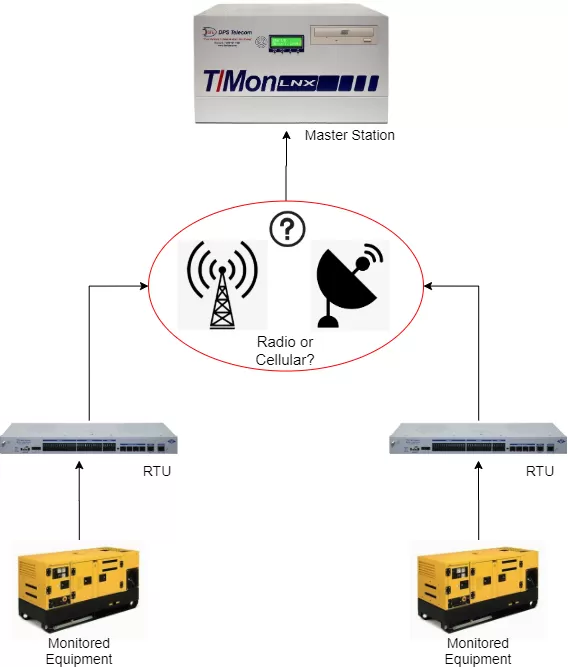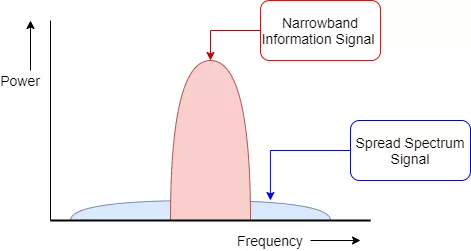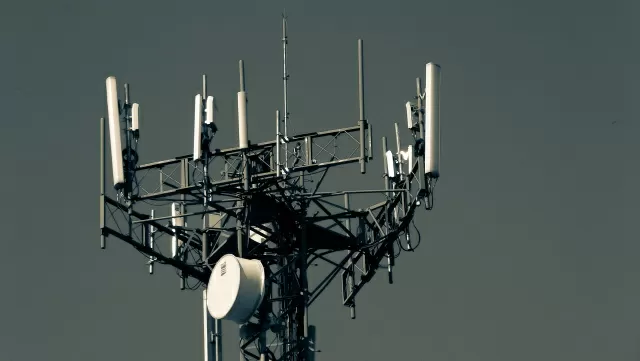Check out our White Paper Series!
A complete library of helpful advice and survival guides for every aspect of system monitoring and control.
1-800-693-0351
Have a specific question? Ask our team of expert engineers and get a specific answer!
Sign up for the next DPS Factory Training!

Whether you're new to our equipment or you've used it for years, DPS factory training is the best way to get more from your monitoring.
Reserve Your Seat TodayIf you are thinking about investing in a SCADA system, it's important to keep in mind that the data transport you will use is one of the most important decisions you will make. This is because the data your RTUs are gathering is only useful if you can access it at all times reliably. If not, you won't have the visibility over your network necessary to react to alarms and prevent problems.
Do you need to brush up on the basics of SCADA? You can start here.
There are many ways (radio, cellular, LAN, etc) that your RTU can transmit remote site information to you or to your master station. And if you can choose what's best for you, even if it's a backup transport, then that's a great opportunity.
As a trusted remote monitoring and control solutions provider, we need that every network is unique, so there's no such a thing as a one-size-fits-all SCADA data transport. In fact, there are many factors that contribute to this choice being unique. However, there are common choices that do work for many companies. Some of them are Spread Spectrum (unlicensed) radio, licensed radio, and cellular.
To help you decide if between these options (and help you make sure they would work for you at all), let's dive into some information about radio and cellular transports and their advantages and disadvantages.

Spread Spectrum radio (aka unlicensed radio) is a very common method of SCADA data transmission. It utilizes radio waves to send information from your RTU to your master station. This type of data transport uses a Federal Communications Commission (FCC) based unregulated band of radio waves in the 900MHz range (maximum of 1 Watt) to send your information.
The Spread Spectrum radio is a system originally developed for military applications, to provide secure communication and prevent detection and interception of signals. This is done by spreading the noise-like signal over a large frequency band.
The fundamental idea of Spread Spectrum is to use more bandwidth than the original message but maintaining the same signal power at the same time. A Spread Spectrum signal doesn't have an obvious peak in the spectrum. So, this makes the signal hard to distinguish from noise, which makes it difficult to intercept.
As an example, you might set your radio to send the first bit on data on 921MHz, the second on 925MHz, the third on 929MHz, and the fourth on 936MHz. The device receiving this transmission is configured to understand this pattern, which ensures that you get all the information while avoiding sticking around on the same channel for long.

The Spread Spectrum type of transmission can bring you many advantages.
First of all, it's unregulated by the FCC, which means that you can buy, install, activate, and tune a system as needed. You don't have to have a permit.
The radio equipment itself is not expensive, and there is no subscription required. After the initial costs with equipment, there are no recurring expenses other than with maintenance. You will pay one time and own your equipment and broadcasting rights.
Also, the radio transport is a very secure way to transmit information. This is due to over the air encryption, the specialized knowledge and gear necessary to intercept signals, and distance limitations (the person that is trying to intercept your signal will have to be within the limited range of the radio waves).
Now, let's talk about the Spread Spectrum disadvantages.
To start keep in mind that it needs a direct line of sight between transmitter and receiver. This means that the signal can be completely affected by physical interferences, such as trees, foliage, buildings, and mountains.
Due to this limitation, the antenna towers will need to be very tall in order to transmit over obstacles. If you have ideal weather and antenna conditions, the Spread Spectrum can reach up to 15 miles. However, in the real world, where the conditions will usually be average and you'll have sufficient line of sight, expect your signal to reach only 1-2 miles.
Another important radio disadvantage to remember is the general threat of lighting strikes. Although most radio antennas will have good lighting protection, you can prevent this natural electric discharge from happening. And when it happens, it can cause major network downtime and major expenses.
The Spread Spectrum radio can be efficiently used if you have a short-range application and already have the infrastructure required to receive and transmit signals, such as towers and poles. It can also be very useful for networks located in remote sites where cell coverage is faulty or nonexistent.
Although the average SCADA system doesn't use much data, the Spread Spectrum radio's 900MHz range makes it possible for your devices to send information quicker (in ideal conditions) than licensed radio or cellular transmission.
Although it has a couple of key differences from the Spread Spectrum radio, the licensed radio is pretty similar to it.
The licensed radio, as you probably guessed, is regulated by the FCC. This means that you need to ask for a permit and they will tell you where on the radio spectrum to broadcast. This usually falls below 500MHz, but there are some situations that allow for the use of a 900MHz. Also, you'll see that the power level of a licensed radio is increased to up to 10W.
The main difference between Spread Spectrum radio and licensed radio is that the licensed bands can be used only by the company that licensed them, but anyone can use the unlicensed bands.
Most of the radio spectrum is licensed by the FCC to certain users, such as television and radio. These users will pay a licensing fee for the exclusive right to transmit on an assigned frequency within a geographical area.
With the licensed radio, just like with Spread Spectrum, you will own your own equipment and there are no recurring subscription fees.
But also, you'll get greater reliability and better performance. The benefit of paying a fee to FCC is not only that you will get the exclusive right to transmit on a determined frequency, but also be assured that nothing will interfere with your transmission.
The FCC regulation will ensure that interference is kept to a minimum. So, if you do get interference in a licensed band, you can work with them to correct the problem.
Furthermore, you'll see a better data transmission performance due to the increased broadcasting power, lower noise, and less competition. Licensed radio doesn't have the same strict line of sight requirements as Spread Spectrum, so it can better avoid obstacles and you can send your signal way further - in ideal conditions, it can reach up to 35 miles.
Although the licensed radio has better performance, it still requires a general line of sight. So, taller antenna towers will still be needed to make sure the integrity of your transmissions. Also, keep in mind that, the higher end of licensed radio's range, the curvature of the earth comes into play, and you'll need even higher towers.
And remember that, you won't be free to retune your radios if needed. You'll be locked into a certain range unless you are allowed to switch.
Licensed radio can be used at most of the same applications as Spread Spectrum. The initial time and investment to get it up and running are higher for the licensed radio, but this could be a good solution for you if you have a situation where the distance or interference make Spread Spectrum unreliable.
Cellular networks are very popular and you are probably with this technology.
Imagine the radio data transmission: it goes from point A directly to point B. On the other hand, cellular technology uses a network of towers, forwarding point A's data from "cell" to "cell" to reach point B.

Cellular communication eliminates one of the most important radio's disadvantages - physical interference in the line of sight transmission. When thinking about transporting your SCADA information via cellular networks, remember your cell phone - the principle is the same.
Cell providers are, of course, interested in keeping their networks online at all times. This means that they do have a huge amount of resources committed to keeping their networks constantly active. This will ultimately benefit your SCADA system as it will become more reliable.
Also, distance is not an issue - if you have network coverage, you'll get data. And there's no need for large towers and lighting-prone antennas. This decreases your costs with maintenance and with possible network downtime.
The main disadvantage of cellular data transport is coverage. If you don't have cell signal, then you won't get your data.
Another limitation of cellular is that there are recurring subscription fees for as long as you want to use the system. SCADA systems don't use much data, so you won't have expensive costs.
Furthermore, it's important to keep the security aspect in mind. Radio has the inherent security that we've talked about previously, but standard cell data transmissions are online. This means that a malicious person can attack your system even from a distance.
The cellular transmission is most likely the most versatile option among those three. So, unless you don't have cell coverage at your sites, it can be used in almost any situation. It also requires less investment and has a simpler implementation than either of the previous radio solutions.
Is radio transport the right solution for you? Or you'd be better off with cellular communication?
Either way, it's important to make sure your RTU can efficiently receive and send information through your chosen transport method. Your optimal situational awareness starts with competent equipment.
The NetGuardian 832A G5 RTU with wireless connectivity that can give complete network visibility over your network. It includes a wireless IP modem and antenna (GSM or CDMA, depending on your chosen build option) for alarm reporting and remote access.

This RTU has three different wireless connection modes that you can select from depending on your application.
The NetGuardian 832A has many other features and capabilities that make it the perfect wireless RTU for many types of networks.
As you surely noticed, there are many aspects that can affect the SCADA data transport you choose. These are common transport solutions, though, because they can work for many different applications.
However, in most cases, network managers can't really choose the data transport method they want. Simply because it's too expensive to replace an already existent one. But, they can still slowly migrate to newer, more efficient data transport technology.
If that's your case, don't worry. We are SCADA experts and we can custom make any of our remote monitoring and control devices to fit the transport you have at your remote sites and the ones you are migrating to.
In fact, no matter what the kind of SCADA data transmission - radio, cellular, satellite, fiber, LAN, etc - we can help you. Just treat us like we were your engineering department. Telling us what you're broadly trying to accomplish allows us to come up with inventive solutions. Our catalog is just a collection of what people have needed before, and we always like to expand it.

Morgana Siggins
Morgana Siggins is a marketing writer, content creator, and documentation specialist at DPS Telecom. She has created over 200 blog articles and videos sharing her years of experience in the remote monitoring industry.